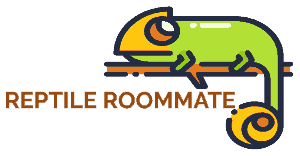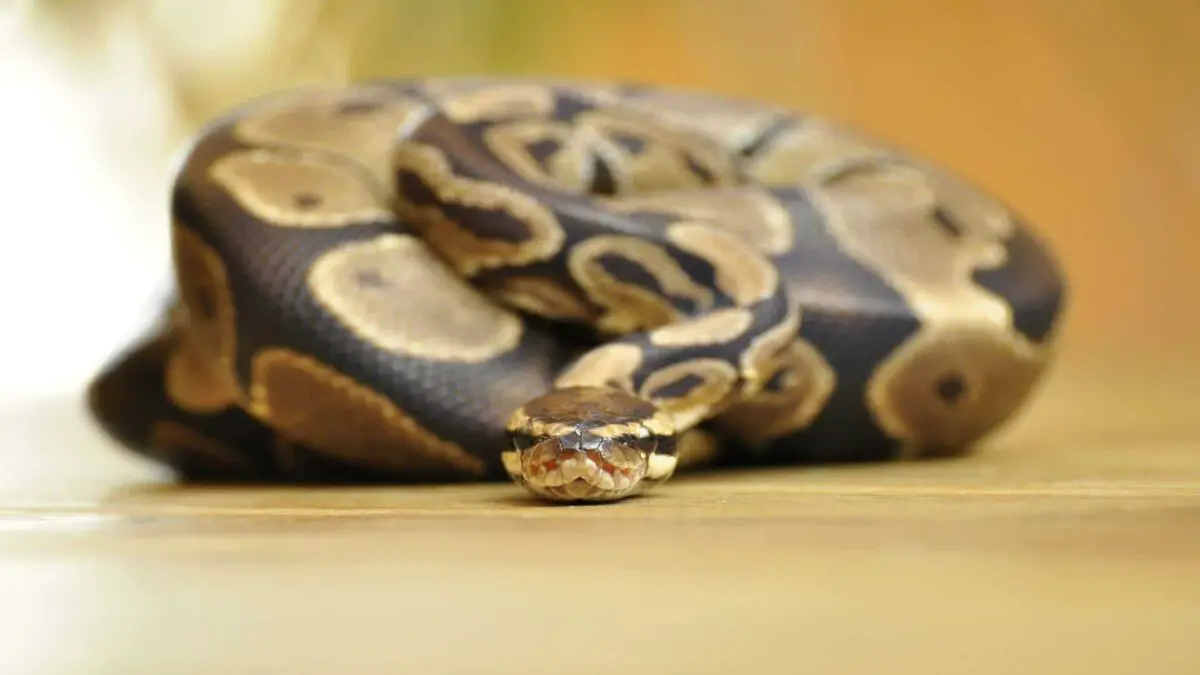Comprehensive Ball Python Care Guide
Ball pythons, also known as royal pythons, make excellent pets! They are one of the most popular reptiles kept as pets.
In this care guide you’ll learn everything needed to set up, maintain, and care for your very own ball python!
Reptile Roommate is a participant in the Amazon Services LLC Associates Program. As an Amazon Associate I earn from qualifying purchases.
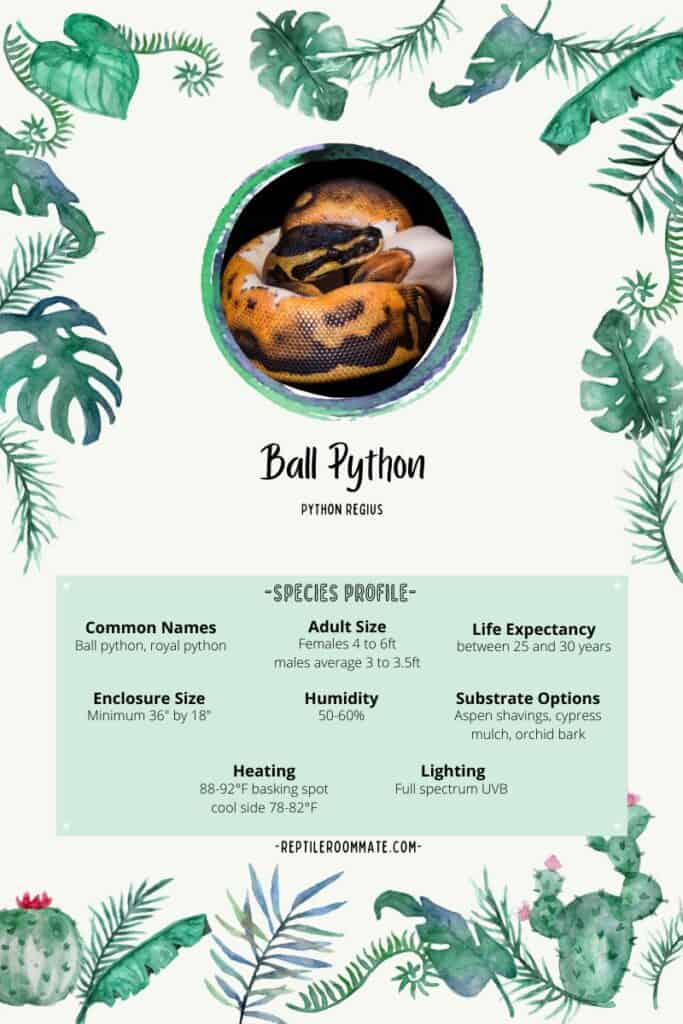
Ball Python Natural Habitat
Ball pythons are native to west Sub Saharan Africa and along the middle of the continent.
Though they have been found to adapt to all types of environments, they prefer sparsely wooded terrain, grasslands, and savannas. Males tend to be a bit more arboreal (living in trees) than females which prefer a more terrestrial habitat.
Ball Python Size
Maximum adult length of these snakes averages about 6 ft. Females, on average, grow anywhere from 4-5 ft which tend to be a bit bigger than males that average between 3-3.5 ft.
Although their heads are relatively small their bodies have a heavier build and they can be quite stocky. For many hobbyists ball pythons are a great “middle ground” between smaller corn snakes and larger boa constrictors.
Ball Python Lifespan
Ball pythons can live on average, for approximately 25-30+ years, although some individuals have reached more than 40 years old!
When you choose a ball python as a pet be prepared to commit to the animal for decades! A young reptile keeper that gets a pet ball python when he’s in middle school may have the snake when he is well into his 40s with a family and children of his own!
Ball Python Colors and Morphs
In the wild ball pythons are usually black or dark brown with lighter colored sides and dorsal patches and blotches. However, captive bred ball pythons have the largest number of variations, or morphs, to be found in the reptile kingdom!
Nearly every conceivable pattern and coloration morphs are available. Most morphs are affordable for the average snake-keeper however there are some rare colors and patterns that command tens of thousands of dollars!
You will not have a difficult time finding the “perfect” ball python to suit your taste!
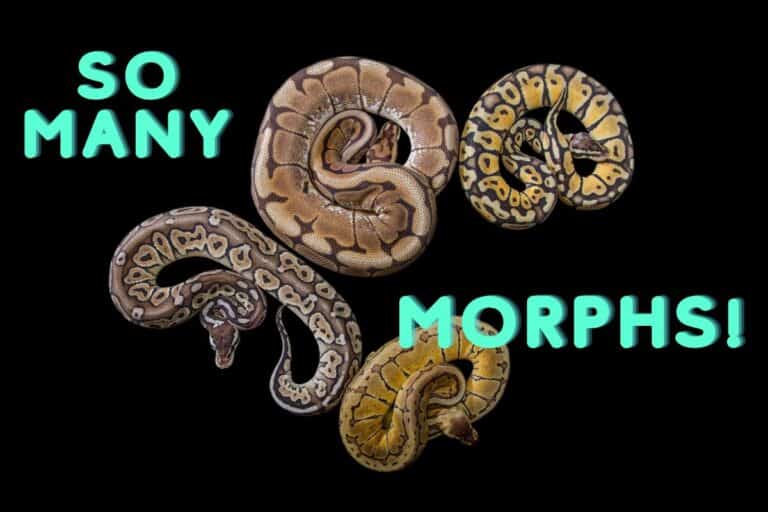
Are Ball Pythons Difficult Pets?
Ball pythons can be great for beginner and experienced reptile keepers!
Their setup and care is simple and undemanding as long as the keeper has their basic care and requirements in order.
Many enthusiasts recommend ball pythons to be the best pet snake for beginners.
Behavior and Temperament
Ball pythons are nocturnal; they become active at night. During other times and mostly throughout the day, your snake will be hiding or sleeping.
It is normal for them to be found resting or hiding in one of their caves or burrows that you’ll provide in their habitat. You may not see your ball python much during the day and if you do see it, you may not notice it move very much during the day.
The common name of the Python Regius is “ball python” for a very good reason; when frightened or threatened they roll into a tight ball with their head tucked inside the coils of their body.
Ball pythons tend to hide (roll up into a ball) more than be aggressive or strike, even when scared or cornered. For this reason, along with an overall mild temperament, ball pythons make great pets!
Do Ball Pythons Bite?
Fact, anything with a mouth can (and probably will) bite you.
That said, a bite from even an adult ball python isn’t something that’s very serious. It’s like a scratch from a cat and usually the most startling thing about getting bit is the initial surprise rather than how much it hurt. Here’s a link to an article that addresses this very topic and shows how you can avoid being bitten altogether.
If a ball pythons does bite, make sure to clean the area well by washing with soap and water and cover the area with a clean, small bandage. (if necessary)
Ball pythons are quite docile and have good temperaments so bites from them are rare.
Handling Your Ball Python
Ball pythons are easy to handle. Some keepers argue that their snakes even seem to “enjoy” being handled. Their enjoyment is up for debate however because no reptiles have a need for interaction like dogs or cats do.
Just always remember, handling any reptile is for the keepers enjoyment and pleasure and not the animal’s.
Like with any animal, initial contact should be slow and steady and trust is developed over a period of time gently handling the snake for a few minutes every day or so for a week to a couple of weeks.
Once your ball python realizes that you pose it no threat, they can be handled with ease and are a pleasure to hold.
Besides avoiding handling your ball python when it is in shed you must not handle your snake after it has consumed a meal. Waiting a few days after you ball python has eaten will help to ensure that it doesn’t stress out your snake and lead to it regurgitating its meal.
Ball Python Enclosures
Being relatively inactive (or at least not very active) an enclosure of about 30 gallons in size is great for an adult ball python. approx 36” x 18” x 12”
Some snake keepers, and especially breeders keep their ball pythons in a rack system. Most ball python rack systems use tubs of @ 30”+ x 18” x 6” high. A couple of advantages to rack systems are that it allows breeders to house large numbers of snakes and it affords easy cleaning and maintenance of the enclosure.
Larger enclosures are very nice both for you and your ball python. However, remember that larger enclosures (and more hides and decorations that you put inside them) need to be cleaned and kept clean.
So, while some may frown on snakes being kept in a rack system, cleanliness and the snakes welfare ALWAYS need to come first. So, if having a rack system means that you’ll be able to provide a cleaner, healthier, and more stable environment then they are a great way to house your snake.
You will need to spot clean the enclosure as needed and do a full tear down of the tank/habitat monthly to clean and disinfect it. Clean = happy keepers and happier reptiles!
Ball pythons should be housed individually and not in pairs or groups.
Humidity
Your ball python enclosure should have a constant humidity of 50-60%.
In order to maintain the humidity you may need to occasionally mist the enclosure or, if your habitat has one, cover part of the mesh screen top to retain moisture.
Misting can be down with a simple spray bottle. Humidity will also be boosted depending on how easily the substrate holds moisture and by maintaining a water bowl in the enclosure.
Using a hydrometer, a device for measuring humidity makes easy work of maintaining proper humidity levels. Fortunately they are inexpensive and readily available.
Substrate
Your ball python’s substrate can be as simple or as complicated as you want. The main purpose of the substrate is to provide a surface for the snake to live in/on, to be efficiently and effectively cleaned, and to be visually appealing.
Substrates such as aspen shavings, cypress mulch and orchid bark (both help maintain humidity), or even something as simple as newspaper or paper towels can work great!
Never use substrates containing cedar as it is deadly to reptiles.
Hides
An absolute necessity for any ball python enclosure is two or more hides or shelters. Most snakes prefer a dark secure place to spend much of their time. The hides you provide give your ball python a secure place to feel safe.
The more hides and safe places you can provide your snake the less stress it will have and the more comfortable it will be.
Heating
Ball pythons need temperature gradients(zones). Their enclosure should have a “warm side” and a “cool side.”
The warm side should range in temperature from 88-92°F and the cool side from 78-82°F.
The most effective means of heating your ball python’s enclosure is by an under-tank heating pad or mat. You can also heat the enclosure with a heating lamp or ceramic heat emitter directed from the outside of the enclosure. (set on top of the screen lid)
NEVER use heating rocks or stones that go inside of the habitat. These can cause severe burns and even death!
An accurate thermometer is a must for any ball python enclosure.
Lighting
Ball pythons have no need for special UVB or supplemental lighting.
However, a photoperiod of 10-12 hrs a day by using a simple fluorescent light (on a timer or turned on/off manually) is standard practice.
Food and Water
Clean, fresh water should be available at all times
A large, stable water dish should be provided. The water dish should be large enough that your ball python can soak in it. Soaking can be very important during shedding.
The water dish should be cleaned and disinfected weekly and as needed.
Most, if not all ball pythons will display some sort of feeding issue or problem over the course of their lives. Just know this beforehand so you can be prepared. It just comes along with owning a ball python.
They may refuse to eat, they may refuse thawed rodents and only eat live rodents. They may eat great one week and not the other, there’s always the possibility of some sort of issue cropping up.
However, knowing that issues can arise and not frantically and helplessly looking for answers to the question, “why is snake not eating?” is more than half the battle.
Let’s first learn what they eat and how much they eat and then we can go over some tips and advice for ball pythons that refuse to eat.
Ball pythons are carnivores; they eat other animals
You should feed your adult ball python every 7-10 days. Smaller, juvenile snakes can be fed more often, about every 5-7 days.
Your ball python can be fed exclusively with mice or small to medium sized rats. As a rule, you can feed your ball python mice or rats that are approximately the same size as your snake is round.
The size of the mouse or the rat will depend on the size of your snake’s midsection.
After feeding your ball python should show a slight bulge in its midsection from the meal. Your snake should NOT have a big lump in its stomach or look like it swallowed a beach ball!
Feeder rodents
Should I feed live rodents or feed previously killed frozen (and then thawed) rodents?
The best option, for both you and your ball python, is to purchase frozen rodents that you can thaw and feed to your snake.
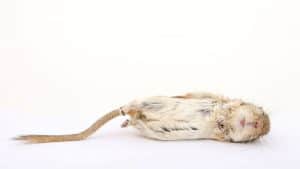
Benefits of feeding frozen/thawed:
- It is convenient
- It’s parasite free
- Rodents cannot harm or cause injury
- More economical because you can buy in bulk
- Frozen rodents are easier to store than live rodents
A second (and admittedly sometimes necessary) option is to feed your ball python live rodents.
Live rodents are what ball pythons eat in the wild. They have evolved to be extremely good predators and are built for hunting, subduing, constricting, and eating rodents.
However, in a captive environment feeding live animal prey is not ideal for a number of reasons.
3 reasons not to feed live rodents
- If left unattended a live rodent can harm, injure or (yes) even kill your snake
- There is the possibility of introducing disease or pests to your snake/enclosure
- Live rodents can be difficult/time consuming/messy/smelly to house
Rodent bites, especially bites from a rat, can do great harm to your snake. IF you do feed live rodents make sure not to leave your snake (and the rodent) unattended until the snake has captured and constricted its prey.
Why won’t my ball python eat?
Ball pythons have a tendency to not eat once and awhile, many times taking us off guard as feeding had been “going so well.”
Some common reasons that your ball python isn’t eating;
- It is in shed or about to go into shed
- Your snake just isn’t interested (or is going through a seasonal “fast”)
- The enclosure is too hot or too cold
- Stress can cause your snake to not eat
- Less common -there may be a heath/medical problem (parasites, infection, etc)
It is common for snakes to refuse food when they are going into shed and it’s best to leave them alone and give them some space during this time.
Some ball pythons seem to go through a seasonal fasting period, either coinciding with outside temperatures or day/night cycles. Other ball pythons will eat consistently year round.
Snakes are cold-blooded animals and as such rely on environmental temperature ranges to regulate bodily functions, including digestion.
Try to provide consistent temperature gradients every day so that your ball python can better regulate itself.
Providing adequate hides for your snake is one of the best ways to reduce stress on your animal. A ball python that is too stressed may refuse to eat or prove to be a finicky eater.
Oftentimes illness of health issues will cause a snake to stop eating. If your snake refuses food make sure to examine it for any signs of illness such as fluid coming from eyes or nostrils, wheezing, or mites and ticks present in and under your snakes scales.
So, your ball python refuses to eat and you’re left wondering what went wrong or what can you do to get them feeding again?
Here’s a handy little checklist that will help in figuring out possible reasons why your snake isn’t eating and some solutions to help it get back on track.
Checklist for snakes refusing to eat
- Check your enclosure’s temperature (hot and cold sides) and make sure your thermometer is accurate.
- Is your ball python stressed? Are you handling it to frequently? Have you made changes to its enclosure?
- Do you have enough hides and secure places for your snake to feel secure? Hides in both the warm and cool end of the habitat are necessary?
- Try wiggling the thawed rodent with your feeding tongs or drag/move it in the enclosure. Sometimes the movement of the food will entice a strike.
- Try leaving the rodent in the snake’s enclosure overnight (NO LIVE rodents)
- Offer the snakes food at night and possibly reduce the frequency of meals for a time.
- Try offering a freshly killed rodent or a live rodent (do not leave live rodent unattended)
- Don’t worry or panic. Ball pythons can be finicky creatures and test out patience sometimes. This is all NORMAL.
Shedding
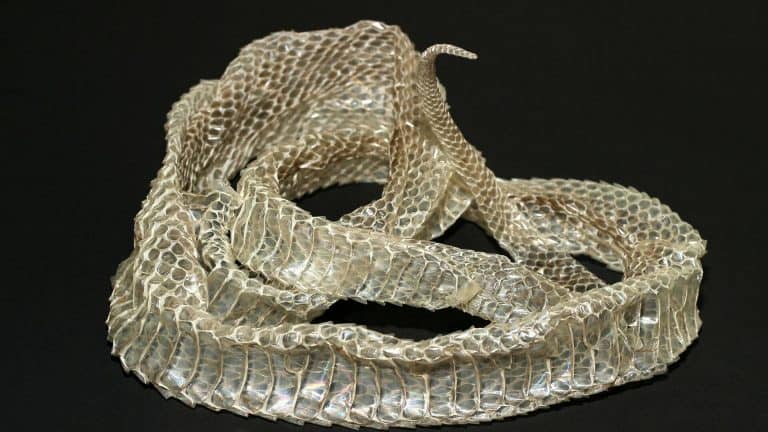
All snakes shed their skin and ball pythons are no exception. Ball pythons continue to grow throughout their lives and as their body increases in size they need to shed their skin to accommodate for this growth.
Shedding can also be beneficial because it may help remove parasites like mites or ticks.
Snakes go through a shedding cycle which can last between 1 and 2 weeks.
The Pre-shed
During this pre-shedding phase you’ll notice that your ball python’s colors appear dull and a bit darker than usual. You may also notice the snake’s eye becoming darker as well or appearing faded.
Some ball pythons will display a pink blushing or tint to their belly. Your snake may begin to refuse to eat at this point which is completely normal!
(once they do refuse food, it’s probably best to stop offering it until they have completed their shed)
Blue
The second part of the pre-shed is what’s known as “being in blue” or the “blue phase.”
Being in blue means that your ball python’s eyes will get cloudy, and appear to be a milky-blue color. Your snake’s skin will also appear to be a lot less colorful and much duller than it usually does.
Your ball python is easily stress during this stage. Cloudy eyes make it hard to see and the impending shed can make your ball python particularly uneasy.
Your snake will spend much of its time hiding and become defensive if you attempt to handle it or are active in its enclosure. It’s best to just give your snake the space it needs.
It can be a good idea to keep a diligent eye on the enclosure’s humidity levels; even increasing them a bit up tp 60-65%.
You can introduce a “humidity box,” or hide filled with slightly damp sphagnum moss to assist your snake in the shedding process.
Approximately 3-5 days later your ball python may begin to look “normal” again. Many new snake keepers wonder, “What happened? Is my ball python not going to shed now?”
Clearing
This “clearing stage” is a normal part of the shedding process as all the fluid between the old and new layers of skin clears up and makes the snake appear much more colorful and brighter.
When your snake “clears up” after “being in blue,” you know the shed is about to begin!
In 2 to 3 days after your ball python has shown signs of the pre-shed “clearing” your snake will soon shed its skin. Snakes tend to shed at night when they feel less stressed and more secure, so you may not see your ball python shed at all.
The Shed
Your ball python rubs its nose against a hide, a decoration, the enclosure wall or substrate to get its skin to begin to peel or crack.
Once its skin begins to peel the snake will wriggle and squirm and move its way around the enclosure rubbing up against anything it can find to help remove the old skin.
Most often a fully shed snake’s skin will come off in one piece, eye caps and the tip of the tail included!
Your ball python may eat a short time after completing its shed or it may skip another meal.
Either is perfectly normal. If your snake does refuse to eat, just try to see if it will feed at the next scheduled meal.
Common Health Problems
Vomiting and regurgitation
The most common cause is from poor husbandry (care). Handling your ball python too soon after feeding can cause your it to vomit/regurgitate. Low enclosure temperature can also cause your snake to vomit/regurgitate.
These two causes account for almost all instances of vomiting and regurgitation. They are both easily corrected.
Diseases resulting in mouth rot
Mouth rot, a symptom of various diseases, is a consequence of unclean habitat conditions, poor husbandry skills, and malnutrition.
Poor shed with retained eye cap
Low humidity, handling your snake while in shed (damaging underlying skin), and low temperatures can lead the eye caps (protective skin covering the eye) to not be shed.
Poor husbandry and an unclean environment will lead to disaster EVERY TIME!
If you are unable to provide a ball python (or any reptile) with the proper environment, please reconsider this choice of pet for the time being.
If you have any questions or concerns about your ball python’s health please contact your local veterinarian!
Ball Python Care Conclusion
This ball python care guide was developed with both you and your snake in mind!
We hope that the information contained here can get you off to a great start and help keep your snake happy, healthy, and in the best shape possible!
As always, good luck and thank you for stopping by!
